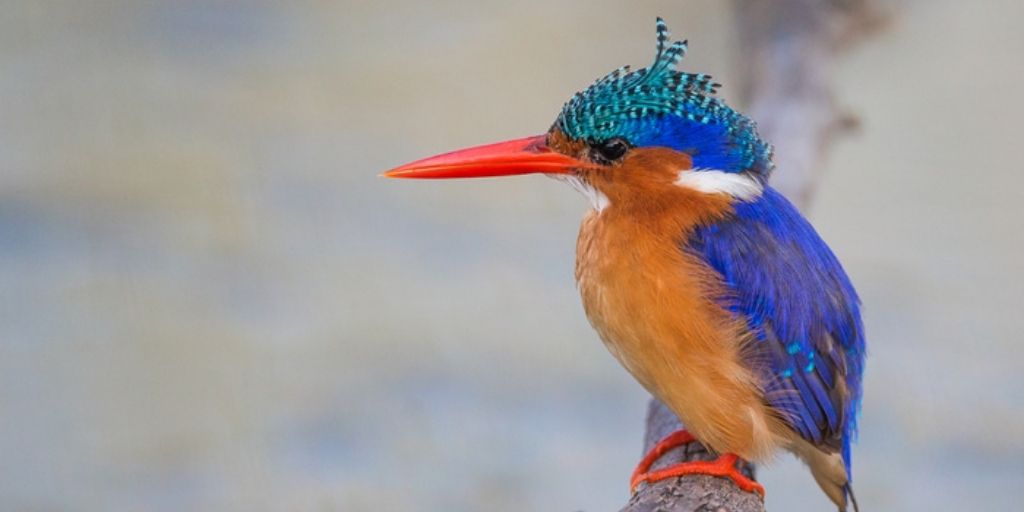Kingfisher is a brightly colored bird that primarily preys on fish. Kingfishers belong to the family Alcedinidae. It’s a family of small to medium-sized birds. The family of Kingfishers consists of 114 species. They are divided into 3 subfamilies and 19 genera. The word kingfisher refers to the common kingfisher in Britain.
Our wildlife guide to the kingfisher covers all the important features of this bird. Let’s quickly get to the sections below for knowing more about the kingfishers.

- Latin name: Alcedo atthis (common kingfisher)
- Family name: Alcedinidae
- Size: 10-46 centimeters
- Weight: 9-500 grams
Skip to: Characteristics, Range & habitat, Diet, Behaviour, Fun facts, Video
Kingfisher characteristics
Kingfishers are small to medium-sized and they have brightly colored feathers. They have large heads, short legs, and stubbed tails. Kingfishers have long, sharp, and pointed bills that help them to catch prey.
The size and weight of kingfishers differ from species to species. Some kingfisher species are small and only weigh 9-12 g. In comparison, some species weigh close to 500 g. However, kingfishers generally have green and blue plumage. The bills of kingfishers are long and dagger-like. The species that hunt fish have longer and more compressed bills. Whereas, species they hunt prey off the ground have shorter and broader bills.
Let’s have a close look at each of the important kingfisher species. You can read about their characteristics below.
African dwarf kingfisher (Ispidina lecontei)
African dwarf kingfisher is the smallest kingfisher in the world. Its length is 10 centimeters and weight is 9-12 grams.
Giant kingfisher (Megaceryle maxima)
Giant kingfisher is the largest kingfisher in Africa. Its height is 41-46 centimeters and weight is 255-426 grams. The bills of the giant kingfishers are large and black. The male giant kingfisher has a chestnut breast band. The females have white spots on their bills.
Shovel-billed kingfisher (Clytoceyx rex)
Shovel-billed kingfisher is also known as a shovel-billed kookaburra. They are 33 cm long. The shovel-billed kingfisher is a tree kingfisher. It has a heavy, short, and broad bill. It is unique among the kingfisher family.
Pied kingfisher (Ceryle rudis)
Pied kingfisher is a water kingfisher. It has black and white plumage. This kingfisher is medium-sized and its size is about 25 cm. It hovers over clear lakes and rivers. Thereafter it dives into the water for fish. This feature makes it distinct from other species.
Kofiau kingfisher (Tanysiptera ellioti)
Kofiau kingfisher is a tree kingfisher and it is also known as kofiau paradise kingfisher. It is also a medium-sized kingfisher and its size is close to 34 cm. It has long tail feathers.
Range & habitat
Kingfishers range extends across all or most of the world in proper habitats. It is mostly found in tropical and temperate regions of the earth. They don’t prefer the polar regions and driest deserts. However, most of the kingfisher species are found in the tropical areas of Africa, Asia, and Oceania. Some of the species live in forests.
The common kingfisher and the belted kingfisher are found in Europe and North America north of Mexico. The Kofiau kingfisher is only restricted to the Kofiau island off New Guinea.
Kingfishers are found in a wide array of habitats. They are mostly seen around the rivers and lakes but they are found in other places too. The red-backed kingfisher lives in the driest deserts of Australia. Some kingfisher species are present in mountains, open woodlands, and tropical coral islands.


Diet
Kingfishers eat a wide variety of prey. Some species are adept in hunting fish. However, some other species of kingfishers feed on frogs, amphibians, annelid worms, mollusks, insects, spiders, centipedes, snakes, different reptiles, and even small birds and mammals.
The kingfishers living in woodlands and forests mainly feed on insects. The water kingfishers feed on fish.
Behavior & lifestyle
Kingfisher species aren’t alike regarding their behavior & lifestyle. Their hunting technique differs as well as food choices. Commonly, a kingfisher sits and waits on a perch for prey. After sensing the right moment they swoop down for catching it with its strong bills.
Several species of kingfishers don’t live near lakes and rivers. Those who live in forests and woodlands make their nests in tree cavities. Some species make nests by digging tunnels into the ground.
Kingfishers have excellent eyesight. They can’t move their eyes within the eye sockets. That’s why they move their heads for tracking prey. They follow a unique technique to kill prey. After catching prey a kingfisher generally flies to the perch. Then it beats it with the bill and breaks the protective spines and bones of the prey. After beating the prey, they swallow it.


Fun kingfisher facts
Here is a list of “Top 5 Fun Kingfisher Facts”. You can read it below.
- Kingfishers are extremely territorial. They defend their territory firmly and don’t surrender until the intruder flies away.
- In the laughing kookaburras family, there are helpers to assist the parents in rearing the offspring.
- Both male and female kingfishers incubate the eggs.
- The red-backed kingfishers hammer into the nests of fairy martins to eat their offspring.
- The pied kingfisher has a bony plate that protects its eyes when it hits the water forcefully.
Meet the kingfisher
Here at SafarisAfricana, you can read such amazing facts about Safari Animals.
Did you enjoy learning more about the kingfisher? Have you ever met this unique creature face-to-face? Tell us about your kingfisher experience in the comment section below. Because those who care share!
References
- Bock, Walter J. (1994). History and Nomenclature of Avian Family-Group Names. Bulletin of the American Museum of Natural History. Number 222. New York: American Museum of Natural History.
- Fry, C. Hilary; Fry, Kathie; Harris, Alan (1992). Kingfishers, Bee-eaters, and Rollers. London: Christopher Helm. ISBN 978-0-7136-8028-7.
- Woodall, Peter (2001). “Family Alcedinidae (Kingfishers)”. In del Hoyo, Josep; Elliott, Andrew; Sargatal, Jordi (eds.). Handbook of the Birds of the World. Volume 6, Mousebirds to Hornbills. Barcelona: Lynx Edicions. pp. 103–187. ISBN 978-84-87334-30-6.
- Fry, Fry & Harris 1992, pp. 195–196.
- Fry, Fry & Harris 1992, pp. 231–232.
- Fry, Fry & Harris 1992, pp. 133–136.
- Bancroft, Wilder; Chamot, Emile M.; Merritt, Ernest; Mason, Clyde W. (1923). “Blue feathers” (PDF). The Auk. 40 (2): 275–300. doi:10.2307/4073818.
- Schulz, M (1998). “Bats and other fauna in disused Fairy Martin Hirundo ariel nests”. Emu. 98 (3): 184–191. doi:10.1071/MU98026.
- Birdlife International (2009). “Todiramphus godeffroyi“. IUCN Red List of Threatened Species. 2009. Archived from the original on 4 June 2011. Retrieved 12 December 2009.
- Douglas Harper (2001). “Online Etymology Dictionary“. Retrieved 14 July 2007.
